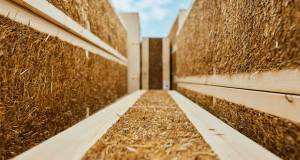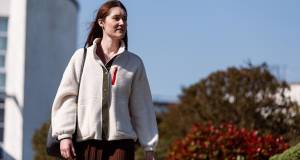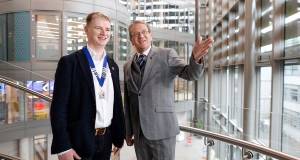- Opinion
- Posted
Climate Change

Atmospheric scientists agree that climate change is happening and will soon become one of the most significant impacting influences on the environment over the next century. Some climate change is part of the natural order, but findings compiled by the Intergovernmental Panel on Climate Change provide evidence that the world is getting warmer, and in mid-latitudes wetter, than could expected under natural cyclic change. These changes, attributed largely to the emission of the ‘greenhouse’ gases carbon dioxide, methane, nitrous oxide and other man-made ones, are forecast to continue.
Ireland is one of the largest per capita emitters of greenhouse gases due to car use, high energy consumption and a large agricultural industry. Agriculture contributed ~35% of Ireland’s greenhouse gas emissions in 1990. In fact agriculture is not only contributing to climate change but will be potentially impacted by it. The Environmental Protection Agency is funding work undertaken at University College Dublin to examine both the impacts and contributions of Irish agriculture to climate change. Some of the potential impacts will be outlined here.
The simplest approach to predicting the impact of climate change is to use knowledge to make informed judgments. A more rigorous approach is to use the same knowledge, formalized as mathematical models and to simulate what may happen in the future. For both approaches it is necessary to have some idea of what the future climate will be like. It is possible to use global estimates and expected trends to deal with this issue but preferably computer simulations of future global weather will be used to obtain data specific to Ireland. The problem that can arise with such data is that it usually represents an area at least the size of Ireland as one homogeneous unit. To overcome this problem, Rowan Fealy and John Sweeney of the Department of Geography at NUI, Maynooth have used statistical downscaling to make climate predictions for a 10 x 10 km grid over Ireland. The resulting data indicates what to expect of the Irish climate during this century. These data results are ideally suited to use with crop simulation models to predict changes in crop yield.
Crop models have been used to predict future yields of barley, maize, potato, soybean and grass. The selected crops provide a good indication of the range of changes that can be expected to influence agricultural production in the future. Results for the differing crops vary across the country and reflect the predicted pattern of climate that can be expected. Looking at some established crops, barley is predicted to show improved yields in the future despite the fact that there may be some limitations of yield due to reduced summer rainfall. This may be offset by the elevated concentration of atmospheric CO2 (the so called ‘CO2 fertilisation’ effect). The expected fall in summer and autumn rainfall, particularly to the north of Dublin is predicted to cause significant yield decreases for potato crops unless more irrigation is introduced. The impact on seed potato production in the North West will probably be less. The data indicates that irrigation requirements of potatoes by the middle of the century could be substantial and unless water stress is managed any potential yield increase from elevated CO2 will be lost. The cost and availability of water, particularly on the east coast is going to be a significant issue for both urban and rural dwellers in the coming years and will perhaps dictate which agricultural enterprises are viable.
Ireland is one of the largest per capita emitters of greenhouse gases due to car use, high energy consumption and a large agricultural industry. Agriculture contributed ~35% of Ireland’s greenhouse gas emissions in 1990. In fact agriculture is not only contributing to climate change but will be potentially impacted by it. The Environmental Protection Agency is funding work undertaken at University College Dublin to examine both the impacts and contributions of Irish agriculture to climate change. Some of the potential impacts will be outlined here.
The simplest approach to predicting the impact of climate change is to use knowledge to make informed judgments. A more rigorous approach is to use the same knowledge, formalized as mathematical models and to simulate what may happen in the future. For both approaches it is necessary to have some idea of what the future climate will be like. It is possible to use global estimates and expected trends to deal with this issue but preferably computer simulations of future global weather will be used to obtain data specific to Ireland. The problem that can arise with such data is that it usually represents an area at least the size of Ireland as one homogeneous unit. To overcome this problem, Rowan Fealy and John Sweeney of the Department of Geography at NUI, Maynooth have used statistical downscaling to make climate predictions for a 10 x 10 km grid over Ireland. The resulting data indicates what to expect of the Irish climate during this century. These data results are ideally suited to use with crop simulation models to predict changes in crop yield.
Crop models have been used to predict future yields of barley, maize, potato, soybean and grass. The selected crops provide a good indication of the range of changes that can be expected to influence agricultural production in the future. Results for the differing crops vary across the country and reflect the predicted pattern of climate that can be expected. Looking at some established crops, barley is predicted to show improved yields in the future despite the fact that there may be some limitations of yield due to reduced summer rainfall. This may be offset by the elevated concentration of atmospheric CO2 (the so called ‘CO2 fertilisation’ effect). The expected fall in summer and autumn rainfall, particularly to the north of Dublin is predicted to cause significant yield decreases for potato crops unless more irrigation is introduced. The impact on seed potato production in the North West will probably be less. The data indicates that irrigation requirements of potatoes by the middle of the century could be substantial and unless water stress is managed any potential yield increase from elevated CO2 will be lost. The cost and availability of water, particularly on the east coast is going to be a significant issue for both urban and rural dwellers in the coming years and will perhaps dictate which agricultural enterprises are viable.
The increase in winter rainfall may also interfere with harvesting. In recent memory (winter 2002/2003) farmers had significant problems extracting tubers from the ground due to water logging. This problem could get worse with climate change making the risk involved with investment in irrigation too serious to contemplate.
The water cost issue could also be significant for farmers who use grass to feed animals. Grass based livestock management is the most important part of Irish agriculture but also responsible for most of the emissions. By the middle of this century, winter and spring yields will probably increase due to elevated CO2 and warmer weather. In the summer, a predicted decrease in rainfall, particularly in the east, will cause drought stress and lower summer yields east of the Shannon. The drought effect is predicted to continue into autumn which may force supplementary feed or even housing by late summer in the extreme south east where losses of 14% of annual yield are predicted. The viability of using irrigation systems for grassland production is open to question at the present time. Currently work also funded by the Environmental Protection Agency is using grassland farm system simulations that include grass growth and management, animal feed demand and grazing and soil interactions to examine the impact of climate change on grassland farming systems rather than just the yields. This is an important step towards providing information for farmers as they adapt their systems to climate change.
Climate change has lead to scientists thinking about the introduction of new crops to Ireland. One example that many people will be aware of is the recent expansion of maize production. Maize is theoretically a marginal crop (hence the need for plastic during germination and early growth stages), but with climate change it can be expected to become a reliable staple that could provide an alternative forage for livestock. Simulation results show that maize will perform best in areas where temperature increases and water supplies are not excessively limited in summer, such as the south west. The model also indicates that the production of seed will be more reliable making the crop more attractive to farmers. Soybean has also been studied because it represents a crop now found in northern Italy that could migrate to Ireland if economic and climatic conditions change. It was found that soybean will probably not be widely adopted in Ireland but that for a few specialist growers, in specific locations it could become economically viable.
Having made predictions of crop yields using simulation models they need to be placed in context. This is not straight-forward because of unpredictable changes to the physical and socio-economic environment of agriculture. There are possibilities however.
According to Teagasc the number and structure of farms is going to alter over the next few years, but a viable crop will always require correct water distribution throughout the year. The most significant climate change implication for agriculture is competition for water to meet any irrigation demands that might arise. For agriculture to remain sustainable it must be economically viable, socially desirable (people must want to do it and others must be willing to accept it) and it must utilize renewable recourses. The economic viability will depend on market prices. If crops such as soybean cease to be produced elsewhere in Europe then perhaps a market may be created in Ireland. The social desirability will depend on those neighbouring such a crop. It is unlikely that urban dwellers will tolerate water shortages in order to allow a particular type of farming to exist and likewise farmers will move on if weather associated risks are too high.
One conclusion drawn from completed research suggests that a westward shift in livestock production for guaranteed grass supply might occur and could leave land in the east and south available for alternative uses. Another scenario could be farmers purchasing off-farm feed supplementation in order to maintain a year-long supply of forage. This could result in a shift towards grassland areas being tilled for alternative forage. However countering the westward shift argument is the expected change in rainfall distribution which will probably make winter field access difficult thus influencing turnout and housing times and access for tillage operations.
Pest and disease management is another factor that will have to adapt to climate change. Current pests and diseases are suited to a warm wet summer and a mild winter. Diseases reliant on surviving in damp conditions in the summer will have problems as will those that cannot survive a warmer winter. The nature and type of spray control will evolve with climate, but it is quite likely that chemical intervention will increase with climate change. A northward migration of European weeds may also be significant; however crops that can benefit from CO2 fertilisation may compete favourably with weed populations.
Many of the climate change impacts identified for Ireland will occur irrespective of the policy decisions taken in Ireland or even Europe over the next few decades. Climate change considerations have not to date been part of the formulation of agricultural policy in Ireland but the impacts predicted suggest that decisions about what crops to grow and where should be ‘climate change proofed’ and assessed for greenhouse gas emissions to evaluate impacts into the future.
Nicholas M. Holden. Biosystems Engineering, University College Dublin.
EPA ERTDI research was funded under the National Development Plan (2000-2006).
The water cost issue could also be significant for farmers who use grass to feed animals. Grass based livestock management is the most important part of Irish agriculture but also responsible for most of the emissions. By the middle of this century, winter and spring yields will probably increase due to elevated CO2 and warmer weather. In the summer, a predicted decrease in rainfall, particularly in the east, will cause drought stress and lower summer yields east of the Shannon. The drought effect is predicted to continue into autumn which may force supplementary feed or even housing by late summer in the extreme south east where losses of 14% of annual yield are predicted. The viability of using irrigation systems for grassland production is open to question at the present time. Currently work also funded by the Environmental Protection Agency is using grassland farm system simulations that include grass growth and management, animal feed demand and grazing and soil interactions to examine the impact of climate change on grassland farming systems rather than just the yields. This is an important step towards providing information for farmers as they adapt their systems to climate change.
Climate change has lead to scientists thinking about the introduction of new crops to Ireland. One example that many people will be aware of is the recent expansion of maize production. Maize is theoretically a marginal crop (hence the need for plastic during germination and early growth stages), but with climate change it can be expected to become a reliable staple that could provide an alternative forage for livestock. Simulation results show that maize will perform best in areas where temperature increases and water supplies are not excessively limited in summer, such as the south west. The model also indicates that the production of seed will be more reliable making the crop more attractive to farmers. Soybean has also been studied because it represents a crop now found in northern Italy that could migrate to Ireland if economic and climatic conditions change. It was found that soybean will probably not be widely adopted in Ireland but that for a few specialist growers, in specific locations it could become economically viable.
Having made predictions of crop yields using simulation models they need to be placed in context. This is not straight-forward because of unpredictable changes to the physical and socio-economic environment of agriculture. There are possibilities however.
According to Teagasc the number and structure of farms is going to alter over the next few years, but a viable crop will always require correct water distribution throughout the year. The most significant climate change implication for agriculture is competition for water to meet any irrigation demands that might arise. For agriculture to remain sustainable it must be economically viable, socially desirable (people must want to do it and others must be willing to accept it) and it must utilize renewable recourses. The economic viability will depend on market prices. If crops such as soybean cease to be produced elsewhere in Europe then perhaps a market may be created in Ireland. The social desirability will depend on those neighbouring such a crop. It is unlikely that urban dwellers will tolerate water shortages in order to allow a particular type of farming to exist and likewise farmers will move on if weather associated risks are too high.
One conclusion drawn from completed research suggests that a westward shift in livestock production for guaranteed grass supply might occur and could leave land in the east and south available for alternative uses. Another scenario could be farmers purchasing off-farm feed supplementation in order to maintain a year-long supply of forage. This could result in a shift towards grassland areas being tilled for alternative forage. However countering the westward shift argument is the expected change in rainfall distribution which will probably make winter field access difficult thus influencing turnout and housing times and access for tillage operations.
Pest and disease management is another factor that will have to adapt to climate change. Current pests and diseases are suited to a warm wet summer and a mild winter. Diseases reliant on surviving in damp conditions in the summer will have problems as will those that cannot survive a warmer winter. The nature and type of spray control will evolve with climate, but it is quite likely that chemical intervention will increase with climate change. A northward migration of European weeds may also be significant; however crops that can benefit from CO2 fertilisation may compete favourably with weed populations.
Many of the climate change impacts identified for Ireland will occur irrespective of the policy decisions taken in Ireland or even Europe over the next few decades. Climate change considerations have not to date been part of the formulation of agricultural policy in Ireland but the impacts predicted suggest that decisions about what crops to grow and where should be ‘climate change proofed’ and assessed for greenhouse gas emissions to evaluate impacts into the future.
Nicholas M. Holden. Biosystems Engineering, University College Dublin.
EPA ERTDI research was funded under the National Development Plan (2000-2006).
- Climate Change
- environment
- energy consumption
- greenhouse gases
- agricultural production
- CO2 fertilisation
- Teagasc
- bio energy
- Ireland
- Nicholas M. Holden. Bio Engineering
- University College Dublin.
Related items
-
 History repeating
History repeating -
 King of the castle
King of the castle -
 Energy poverty and electric heating
Energy poverty and electric heating -
 Build Homes Better updates Isoquick certification to tackle brick support challenge
Build Homes Better updates Isoquick certification to tackle brick support challenge -
 Flat earth
Flat earth -
 Material matters - A palette for a vulnerable planet
Material matters - A palette for a vulnerable planet -
 Derelict to dream home
Derelict to dream home -
 Final opportunity for construction professionals to secure 80 per cent training subsidies
Final opportunity for construction professionals to secure 80 per cent training subsidies -
 Big picture - Points of access to resilient living
Big picture - Points of access to resilient living -
 Storm breaker
Storm breaker -
 Enniscorthy to host ‘make or break’ sustainable building summit
Enniscorthy to host ‘make or break’ sustainable building summit -
 Ecocem executive John Reddy becomes the first Irish President of the Institute of Concrete Technology
Ecocem executive John Reddy becomes the first Irish President of the Institute of Concrete Technology

